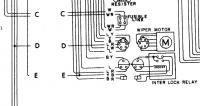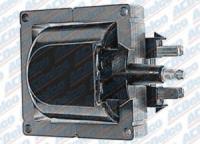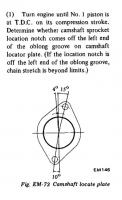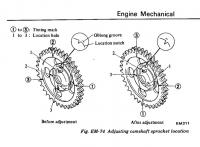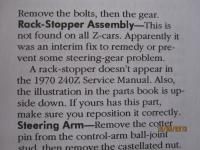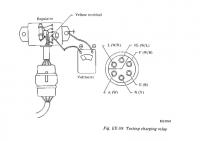Everything posted by Zed Head
-
Checking Timing Chain Stretch
Something seems weird then. One of those three holes should be up near the top so that you can look through it. I think that each one has a notch. And one of those three holes that was under the bolt washer should have the can shaft dowel in it, you can check that. Maybe someone in the past broke the dowel and eyeballed the camshaft sprocket in to place, locking it down with clamping pressure. One of the guys on here who's done more engine work should have an idea. Doesn't look right (to me) for the settings you described.
-
Checking Timing Chain Stretch
Is that picture from when you had everything set to zero? No sprocket bolt, and the holes in the sprocket aren't at the top where the groove is. You might be on the exhaust stroke for piston position. The timing mark actually passes zero twice for each chain sprocket revolution. Check that the cam lobes are both up, not contacting the rocker arms. The sprocket has the 1, 2 and 3 adjustment holes so it should have the notch also, to show the need for adjustment. The first is not much good without the second.
-
Help with Throttle Position Sensor 78 280 Z
What does it do when it lacks power? Does it cough and buck and backfire, or just "bog" when you give it gas, or blubber and choke like it's flooding? With 45 psi you might have been running rich with fouled plugs, and finally fouled too many on the way for the engine to run. Coughing and back-firing is typical of lean, fouling plugs can happen if it's rich. "Bogging" could be timing. I would pull the plugs to see what the few miles of driving did to them (keep them in order 1 - 6 in case you have cylinder-specific problems), test all of the EFI components from the ECU connector that you can figure out from the FSM so you'll know from the start what the ECU sees, and check the timing (pretty common to have someone turn the distributor to see what happens and get the timing either way retarded or way advanced). Didn't realize it was that bad. Good luck.
-
SS Voltage Regulator
I think that the fact that you knocked the cap off with your hand shows that it wasn't properly locked down anyway. So, probably lucky in the long run. You could have spent hours trying to find the source of a random miss, caused by the cap moving around. All of the Z's seem to be on the edge for amps at idle. An extra 100 engine RPM can make a big difference. I've also found that the factory made alternators seem to put out more idle current than the typical aftermarket alternator. Personally, I will always run old Nissan alternators until I run out, over "new" refurbished parts store alternators, but I have several wrecking yards in the area to choose from. And there's no guarantee that more peak output will produce more idle output, the output curve slopes seem to change between various alternator brands. It's a dilemma.
-
Do spindle pins need to come out for springs/insulators?
To add a little to what Jon M. said - on the 280Z you'll need to loosen the control arm inner mounts a little bit to get the top of the strut out from under the fenderwell (I think JM has a 240Z). The 280Z strut is taller than the 240Z so it needs to drop down farther to clear (Blue's three 240Z links may not apply directly). But it is doable, I swapped my rear springs a while ago doing it that way. I think that I might have left the brake lines attached too, but it's risky. If things slip you can damage them. If I recall, I also had to disconnect the halfshafts because they wouldn't drop down far enough otherwise. The thing about these time-savers though, is that after your first try you'll probably get done and say "it would have been faster if I had just taken it out completely". You'll forget something or something will slip or you'll get in a bind and spend time thinking instead of doing. After you've done one, the short-cuts make more sense.
-
280Z Full Restore in 5 months, hopefully.
Whose Goat? rcb is right. Topsy-turvy.
-
Starter question
You could reconnect everything to see if the switch is bad. If it still does it, ordering a switch might be a good idea. If not, you've ordered an extra switch. I copied the relay picture. I didn't follow all the traces but yellow/black is power to the starter solenoid (it's where "E" goes). Black/yellow is the other side of the relay, which I think is what needs power. SteveJ probably knows but maybe you went yellow/black, when you should have went black/yellow, and connected switched power to the solenoid.
-
Starter question
I'm going to guess that you jumped the wrong wires. Just because everything worked fine before. On the 76 cars, the power to the starter solenoid and the power to the ignition system are all on completely separate circuits, initiated at the ignition switch. Odds are you've jumped switched power to the starter solenoid wire The wiring diagram for the 260Z is harder to look at but here's a link if you want to dig in - http://www.atlanticz.ca/zclub/techtips/wiringdiagrams/74_260z_manual_wire.gif
-
GM HEI Module Install
Just offering a counterpoint - there are numerous discussions around the internet also about the possibility that the high RPM weakness is either just a myth or is an early problem that was solved quickly. Many, many stories out there about no signs at all of high RPM problems. The cynic in me says that the aftermarket ignition module and coil companies have benefited greatly from this myth, and actually keep it alive with their unsubstantiated advertising claims. If you search, I think that you might find one decent article about the GM HEI system having a high RPM problem. I looked all over and there's very little real evidence of a problem, just repetition of something heard (no offense). I also found a reference somewhere quoting the guy who inadvertently started the initial rumor (might have been David Vizard) saying that his initial comments had been blown out of proportion and the GM HEI system was a good one. It was in a newer fuel injection tuning book in a book store so I may never see it again though. Edit - here's a link to a comment about Vizard and what might have been the book I was browsing. Not FI, but small-block chevys - http://cyberdave.org/HEICoilInfo.html If you read the whole link though, you end up with someone postulating again, with no evidence. It's like the perfect endless discussion topic. Lots of evidence for and lots against, and infinite combinations in between. On the coil - GM actually made an external coil for the early Novas and trucks (late 60's). You can buy it from Rock Auto or a parts store. This gives you the actual GM system, except for the triggering system in the distributor, which is based on the same principle. I have the standard (BWD, not high performance) HEI module and the GM coil on my engine and it works fine with no issues. Not even a sign. But my stock L28 is done pulling by about 5,500 RPM so I never go higher.
- Help with Throttle Position Sensor 78 280 Z
-
Problem removing trans rear extension
Just realized that my comments about the shift rods sliding out of the adapter are for the front cover coming off. Eurodat's comments are more relevant I'm sure, he's spent more time inside these transmissions than I have.
-
Stumped in New Mexico
The procedure is described in the FSM, Engine Mechanical chapter, about pages 18-20. Any 280Z FSM should work. I've found that Nissan changed the shape of the notch to a square groove for the ZX engines so you might look for that also. It's on the back of the timing chain sprocket, right above its hub or center, right in front of the camshaft retaining plate. The oblong groove is stamped or engraved in the plate. I attached a picture of the plate with the notch (it's right below the "4") and the illustration of what to look for. It's something that's easy to do and will confirm proper orientation of many different engine components, all in one shot.
-
vibration
I replaced my chattering Zoom Perfection (from NAPA) clutch with a Rhinopac. I can't say if the chattering of the Zoom clutch came from the clutch or the flywheel (I did not have it refinished before installing) but I can say that the Rhinopac is very smooth and has a lighter pedal (less pressure required). They're both OEM spec. so I think that the Rhinopac might be more precisely made to allow more leverage on the pressure plate. In short, I like Rhinopac over Zoom Perfection.
-
Help with Throttle Position Sensor 78 280 Z
Did he say that you needed a new TPS or are you assuming? You might be misunderstanding what his remarks mean. There are only three positions for the throttle valve (aka position) switch - idle, wide open throttle and in-between. If he ran the check in the FSM and got the right values, then you don't need a TPS. Don't buy a new switch. It's not a variable sensor like on some modern engines. You might need a new mechanic. It sounds like he's guessing and not using the FSM or EFI Handbook, because 45 psi fuel pressure is normal for some modern engines but is way too high for these engines. 36.3 psi is the proper number and he should have known that. High fuel pressure would cause the engine to run rich and the exhaust to smell like gasoline. Old skilled mechanics are sometimes over-confident and will try to figure things out by looking and testing, instead of doing things the right way.
-
Double checking ball joint to control arm torque??
Look at Post #18 here - Suspension Bolts - Inventory - Brakes, Wheels, Suspension and Chassis - HybridZ Looks like there's a mistake in the FSM. You'll need to convert Newton-meters to foot-lbs. Newton Meter Conversion Chart (Torque Units Converter, Metric)
-
Problem removing trans rear extension
Is it a solid "no movement" or a squishy "barely moving"? If I recall right, the shift rods tend to bind a little in their holes in the center plate (adapter plate in the FSM), due to a little bit of mushrooming in certain areas. I'm just guessing, so be careful. I think it just takes a lot of awkward tapping to get everything out. Could also be that you're not in neutral. The balls on the shift rod move in to spaces on the adapter (or vice versa) if not in neutral and the rod can't come out. Just guessing again. It's probably a shift rod that's sticking though.
-
Stumped in New Mexico
It's not perfect, due to chain stretch, but you can get a pretty good estimate of how bad the mark might be off, or find the right one, by pulling the valve cover, turning the engine over until the #1 cylinder cam lobes are pointed up, then turning the engine a little more (in it's normal rotation - to keep the chain tight) and aligning the notch on the timing chain sprocket with the groove in the cam plate (as described in the Engine Mechanical chapter). Could be that the wrong pulley mark is being used. If the right one is on the damper pulley and nothing is damaged, and the cam shaft is installed properly, this would find it. Another possibility is that the engine has a 240Z damper that is marked for the opposite side of the engine, and someone cobbled together a ZX style pointer because they lost the other one when they installed the 280Z engine. If so, the procedure above will end up with a damper pulley mark under the distributor somewhere. An early 240Z pointer might solve the problem. I don't know when they switched, and I can't find a reference but I've read that the early Z's had the mark on the driver's side.
-
vibration
Your clutch is probably either worn out or has a problem at the friction surfaces. I had one that did what you described when it got warm. The hotter the weather and the longer I drove it the worse it got. It could get really bad, shaking the whole car. It was okay when cold. Changed the clutch, flywheel (I had a spare) and pressure plate and I was back to smooth take-off.
-
vibration
I would think something from the driveshaft back to the rear wheels. Pieces that get extra load under acceleration and can twist out of shape if something is worn or loose. OR, it could be a sticky clutch. I had one of those. Does it happen while releasing the clutch pedal to get going, or after the clutch is fully engaged (pedal all the way up for those iffy on "engaged") and you're on the throttle?
-
Rack and pinion U-bolt clamp ? 71Z
Here's an interesting paragraph from Humble's Restore book. I wonder if the forum's parts CD has an illustration of the referenced upside-down installation.
-
alternator issues, looking to upgrade possibly.
Looks like Black is ground (Earth). Hard to tell what it's grounding though from the drawings. Sometimes Nissan runs a dedicated ground wire to the cover. Check the cover for solder. Didn't realize also that you were dealing with past problems and broken wires, your first post made it sound like this was a fresh problem. That kind of changes the situation. The internally regulated alternator might be the way to go, although it could take some problem solving to fix other things that might be affected by the external VR. You'll go from 50 amps to 60 with the ZX alt which might be worth doing anyway. But I think that might be possible just by getting a 1976 externally regulated alternator. Many paths possible.
-
alternator issues, looking to upgrade possibly.
You didn't say anything about precision. I'm not sure what that means here, since it just needs to be wiithin a certain fairly wide range of charging voltage. Seemed like you were implying that you might have problems, and really, the only problem you have with a VR is when it fails. I was referring to VR failures. The solid state VR might last longer under normal conditions, but the mechanical would handle the abnormal conditions better, I think.
-
alternator issues, looking to upgrade possibly.
Actually, the solid state VR's tend to have more problems with stray voltage spikes from things like ignition systems, or too much current flow from things like charging dead batteries. The old mechanical systems should be fairly robust. You should call MSA on that alternator and see if you're paying the extra $20 for real higher output or just the turbo name. Ask if they have output specs. for each unit.
-
Looking for input on exhaust ideas.
The drone is typically solved with a second muffler midway down the system. Stock Z's came with anti-resonation mufflers in that spot. You might try a simple modification there before buying a whole new system, at least to know what you need first. Many people use a glass pack instead of the stock anti-resonation muffler and say it does the job fine. The stock piece is a little bit restrictive.
-
Noobie here needs Fuel pump help!
I've had one bad ECU and its death characteristics were to die instantly, come back to life for about 1/2 mile, die again, start again, die again, flood the engine with fuel, then never start again. I replaced the two injector transistors and got it to work again (just for fun, not because I knew what I was doing) but have only taken it for a test drive since then. Something to consider is that the transistors used for the injectors are very similar to those used in the ignition module, and ignition modules do weird things before they crap out for good.




